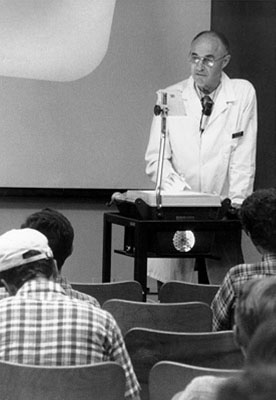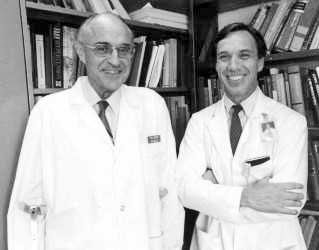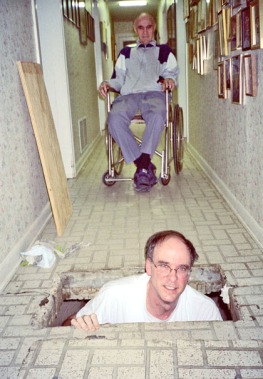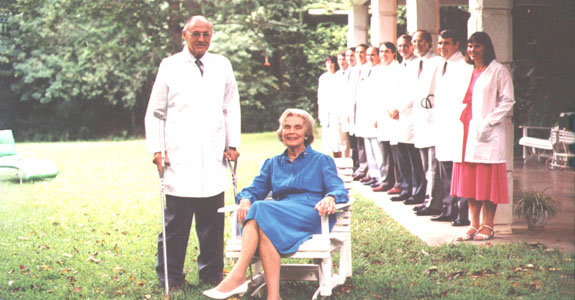When Arthur Guyton assumed the chair of physiology at the 2-year University of Mississippi Medical School in Oxford in 1948, he recognized a personal inadequacy because he actually never had taken a full graduate physiology curriculum. His knowledge derived only from medical school courses at Harvard, as well as what he had picked up in surgical internship and brief surgical residency and his term with the Navy in the war.
Accordingly at Ole Miss he taught himself physiology ahead of his students. Pressed for time, he felt an imperative not to let his mind wander into interesting areas in depth, but just to focus on the main concepts and to keep them well organized. A popular physiology textbook at the time, Best and Taylor, was encyclopedic in its coverage of each topic, leaving to the student the task of deciding what was really important.
Arthur recalled those days in an interview with Allen Weisse:
The overhead-type classroom projectors had just come out, where you could write on or draw on clear plastic film and project it on a screen. At night, at home, preceding each upcoming lecture, I would draw pictures on plastic stencils covering different subjects I wanted to talk about the next day. I would literally spend six or eight hours straight, first reading what Best and Taylor would say or what Wiggers or others would have to say…. Then I would leave myself about three hours to collect my thoughts and make an outline of the lecture. Next, I would use another hour to make eight or ten drawings, so that I could project these for the lecture. This worked fairly well; I did this every six months as each new [medical school] class arrived. After about ten of those series, I realized that there was no book to which the students could refer. For this reason, I began to dictate summaries of my lectures after having delivered them, and I gave them to our secretaries to transcribe. That was another two hours of work. It made a pretty full day – sixteen or seventeen hours. That went on for a total of ninety days, the duration of the course, and those dictations constituted the first edition of the text.[1]
The dictated summaries ultimately became the first edition of Arthur’s Textbook of Medical Physiology. He described its genesis further:
We were fortunate to have an excellent secretarial pool at the time, and the secretaries were able to transcribe the dictations without requiring much correcting on my part. We were usually able to get the summaries to the students within a day or two….
Then I found that the next class already had these notes handed down from the previous class, and the students wouldn’t read the textbook at all. I thought to myself, “Well, if they’re going to do it that way, I had better dictate this much more fully.”[2]
Coupled with new concepts in circulatory physiology developed in his laboratory, Arthur’s teaching methods and dictated summaries led to the textbook, first published in 1956, that within a decade became the most widely used physiology text for medical students in the U.S.
Most medical textbooks have many authors, each of whom might work on one to three chapters. Writing a single chapter adds considerably to the daily effort of an author over a period of months. Arthur Guyton revised his entire textbook by himself every 5 years.
This work proceeded almost constantly. Sometimes he would dictate revisions onto a tape at his office or at home to be transcribed by a secretary. More often, he would simply handwrite emendations on a double-spaced manuscript while sitting in a living room chair at home in the evening, oblivious to the children who used the long hallway behind him as a bowling alley or a challenging narrow space for dodge ball, whooping and fussing for an hour or two after homework was done. Despite that level of concentration, whenever we had a question for him – schoolwork, a science project, or adjudication of a dispute – Daddy always stopped his work to make time to talk.
He once gave me advice on writing: Don’t make your reader have to work to figure out what you mean, Johnny. Your readers are not lazy people, but busy, and they have far less time to invest in the text of your writing than you. Therefore, any writer should counterbalance his own familiarity with the material by imagining his readers to be the laziest people in the world. Make the meaning of your words clear and unavoidable.

In the mid-1990s John Hall, a former postdoctoral fellow from Michigan, joined Arthur in writing and revising the textbook. By then John had succeeded Arthur as chair of physiology at the Medical Center.
An abundance of explanatory figures, avoidance of unnecessary detail, well-balanced organization, and consistent clear writing style made the Textbook of Medical Physiology well received by medical students not only in the U.S., but around the world. It pleased Arthur to keep a shelf in his electronics workroom at home filled with foreign language translations of the book, 15 in all. It is the most widely published medical textbook of all time, surpassing Gray’s Anatomy.[3]
The Department of Physiology grew in size. We children saw it in the annual physiology family picnic held at our house, which our parents organized every summer. One of us climbed on the full-sized tractor with a bushhog attachment to mow the grass. The sandbox, tennis court, and swimming pool we had built were filled with friends in the department and their children. Ruth might have allowed beer or wine, but Arthur nixed them. He felt you didn’t need alcohol to throw a good party.
In his laboratory work at the Medical Center, Arthur always needed help to perform the physical work of a dog experiment. He found it necessary to be a teacher, because he could not be the surgeon performing the experiment. His students learned better that way. His hours spent in a spartan office were never so busy that he turned away a student who needed an answer or some inspiration.
Arthur mentored more than 150 scientists in physiology at the University of Mississippi. Among them, at least 27 became department chairs at various institutions around the U.S. and the world.[4] Even the children came to recognize Dr. Sagawa from Japan and Dr. Kahlil from Egypt. Six physiologists including John Hall from the department followed Arthur as presidents of the American Physiological Society.
All 10 of the Guyton children went to medical school, received M.D. degrees, and went into academic or private practice (pictured at the top of this blog). Seven boys attended the same institutions as our father, Ole Miss for undergraduate work, usually in physics, and Harvard Medical School. Greg, trailing the rest by 6 years, went to Vanderbilt first and then Harvard Med. Cathy and Jean went to Harvard College and subsequently obtained their medical degrees at Miami and Duke, respectively.
How could 10 children, one after another, freely make the same career choice? Practical advice was part of it. I remember Daddy saying to me something similar to what he heard from his father, Billy Guyton, “If you’re going to be a physicist, how are you going to make a living?”[5] Doug, number seven in line, took a short hiatus from his term at Ole Miss, explaining “I had to figure out who I was. I had the feeling I was doing what was expected of me – instead of what I wanted to do. But Daddy wasn’t about to let me founder. He exerted the pressure of logic and gave me support at the same time.” Eventually Doug found a satisfying, productive medical career in anesthesiology. “I no longer feel obliged to uphold a family standard,” he has said. “I’m doing what I want to do.”[6]
The average onlooker might assume a distinct lack of originality on the part of the children – a lack of personal will. A social scientist, adhering to a creed that avoids any reference to will, might categorize the influences of modeling and powerful teaching methods employed by both parents, as well as the broader environment of the late 20th century. But there is another way to describe it. Will can arise in the family dome, which combines or intersects with the individual.

On a winter weekend in the 1990s, John Hall received an anxious telephone call from Ruth or Arthur. All of the Guyton children were living elsewhere at that time. The furnace was out, and they didn’t think a repairman would be able to come quickly. The temperature was almost freezing in the house; they feared catching pneumonia. Could the current department chair come out to Meadow Road to help? Of course he could.
At Arthur’s direction, John lifted the concrete slab in the middle of the hallway, then climbed down into “the hole.” Fortunately the problem was reasonably straightforward. With Arthur’s experience guiding him from above, John soon had the pilot light burning and the furnace back in action. He was not the only friend who might have come, but he was available. He was family, duly initiated.
This dedication[7] in the Guyton-Hall Textbook of Medical Physiology helps to put the work of learning physiology into context:
Next post: Neighbors and Family
Previous post: Slowly Rising Pressure
Searching for GSOT outline: Home
Featured image: Arthur and Ruth with ten children, all current or future physicians, in front of the big concrete house. Photo of Arthur Guyton lecturing at the University of Mississippi Medical Center. Photo of Arthur Guyton and John E. Hall, with permission of the latter. Conceptualization of John in “the hole,” mixed sources.
[1] Weisse, A.B. Heart to Heart: the Twentieth Century Battle against Cardiac Disease, an Oral History. Rutgers University Press, New Brunswick, New Jersey, 2002, pp. 115-133.
[2] Ibid.
[3] URL https://www.umc.edu/The_Guyton_Obituary.aspx, accessed 2/13/2016.
[4] Ibid.
[5] Ibid.
[6] Richard Bode. A doctor who’s dad to seven doctors – so far! Reader’s Digest. 1982, December, pp.141-145.
[7] Guyton, A.C, and Hall, J.E. Textbook of Medical Physiology, 9th edition. Saunders, Philadelphia, 1996.


I am delighted to find your writings and especially to read this remarkable one. Respect for the Guytons knows no bounds; in our family this couple is revered! I shared a slice of history via essay on the student who was privileged to be part of this ambitious project in 1955 when Dr. Guyton selected him to draw the original figures for his books. That choice changed the life of my father who is still practicing medicine full-time in Mississippi at almost 84 years of age. Cherished personal letters and cards from Dr. Guyton hang in the office and continue to inspire daily!